¶ Neunaber Immerse Reverberator Mk II
Thank you for purchasing our product. We really mean it. We hope to earn your trust by delivering a quality product that inspires you to make great music.
Neunaber products are designed and manufactured in Orange, California USA.
¶ Introduction
The Immerse Mk II represents the very best in pedal reverberation — with studio-quality algorithms, high-fidelity circuitry, heavy-duty components and construction — all in a small footprint. The Mk II is a monumental step forward and features completely-redesigned circuitry and upgraded algorithms:
- Mix adjustable from 100% dry to 100% wet
- Increased headroom
- New W3T reverb algorithm
- New Sustain effect
- Various improvements to most effects
- Easier-to-read graphic layout
The Mk II implements a high-quality buffered bypass. The signal is always buffered whether engaged or bypassed. We chose this type of bypass because the last output in a pedal chain should be buffered, and reverb is typically placed at the end of a pedal chain.
¶ Signal Chain
Q: Where do you place this effect? A: Reverb sounds best at the end of the chain.

¶ Effects Loop
Using the drive channel of your amp? Connect reverb in the effects loop.
Note: Enable kill dry for parallel FX loops only.
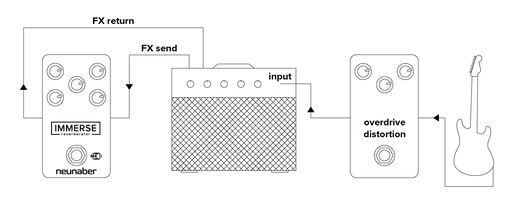
¶ Connections
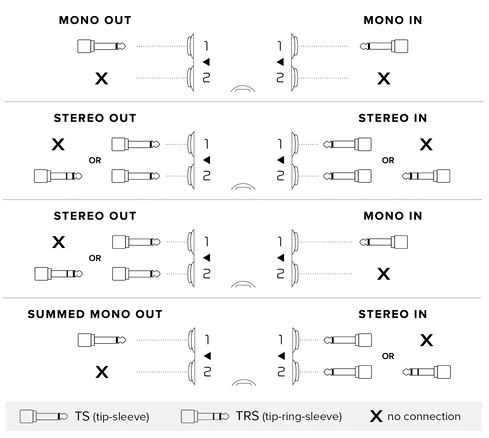
The Power Jack accepts a standard (5.5 mm OD x 2.1 mm ID) center-negative pedal power adapter (not included). The power adapter must be between 9 V and 12 V and capable of supplying 80 mA or more.
The Input Jacks accept inputs directly from your instrument, amplifier effects loop send, or other effect pedals via standard 1/4” (6.35 mm) phone connectors.Inputs 1 and 2 should not be used with two discrete signals, such as two different instruments.
The Output Jacks supply output to another effect pedal, an amplifier, or effects loop return via standard 1/4” (6.35 mm) phone connectors. The output is buffered and capable of driving long cables.
¶ Switches
The Footswitch engages the effect, and the LED lights when the effect is active.
There are two mini-switches next to the Power jack:
- Kill Dry removes the dry signal, even when bypassed. This should be enabled for parallel effect loops and disabled for serial (common) effect loops.
- Trails allows the effect to naturally trail after the pedal is bypassed. With normal bypassing, the effect is abruptly cut off; however, normal bypassing results in lower noise while the pedal is bypassed.
¶ Effects
¶ W3T™
Version 3 of the WET algorithm — our flagship reverb. Smoother decay and more three-dimensional sounding, it enhances what you play without covering it. Adjustable pre-delay further separates the dry signal and reverb up to an additional 200 milliseconds (ms).
¶ Plate
A physical plate reverb uses transducers mounted to a large, suspended metal plate. It is known for its bright, diffused sound. Adjustable pre-delay further separates the dry signal and reverb up to an additional 200 ms.
¶ Hall
Hall reverb simulates the sound of a well-designed concert hall. The Mod knob controls the modulation depth — try increasing it for a lush, modulated hall reverb.
¶ Spring
A physical spring reverb uses metal springs suspended between transducers and produces a distinctive “twerp.” The Mod knob increases the modulation rate — try increasing the modulation rate for a classic vibrato-spring reverb sound.
¶ Sustain
Built on our W3T reverb, Sustain is a magical effect that can be configured as a sustain effect or virtually infinite reverb. What you play is recycled in an infinite loop during a ”hold” phase, then decays out during a “release” phase. The Time knob adjusts the hold time, while the Depth knob adjusts the release. The Mod knob controls the modulation depth.
¶ Echo
This effect adds echo and reverb. The Time knob adjusts the echo time, from 50 to 700 ms. Depth controls both the reverb decay and echo repeats. Blend controls the mix between the reverb and echo effects.
¶ ↓tune
Detune is an effect that pitch-transposes a signal slightly downward. This effect adds detune to a detuned reverb to produce a thick, chorus-like effect. The Blend knob controls the mix between the reverb and detune effects.
¶ Shim
Shimmer is a reverb effect reminiscent of a synth pad that follows what your instrument plays. The Blend knob controls the mix between the reverb and shimmer effects.
¶ Controls
¶ Mix
The Mix knob adjusts the blend of dry (unaffected) signal to effect and ranges from 100% dry to 100% effect.
¶ Effect
The center knob selects the reverb effect. The knobs below may change function depending on the selected effect.
¶ Depth
The Depth knob controls the reverb depth (also called decay time). When the Echo effect is selected, it also controls the
number of repeats (regeneration).
¶ Time / Tone
This knob adjusts the effect tone except as follows:
- Sustain, knob controls Hold time
- Echo, knob controls the Delay time
¶ Pre-dly / Mod / Blend
This knob controls the reverb-to-effect blend except as follows:
- W3T and Plate, knob controls pre-delay
- Hall and Sustain, knob controls modulation depth
- Spring, knob controls modulation rate
¶ Example Settings
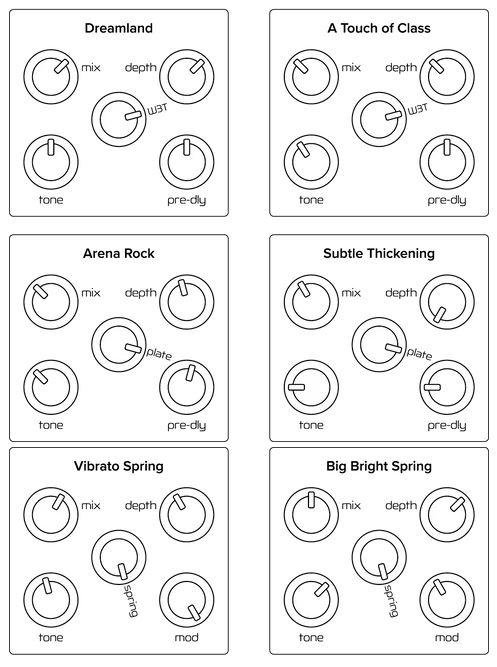
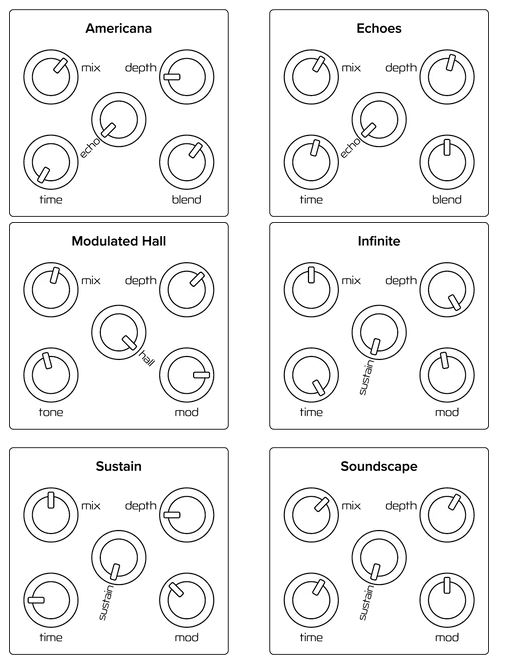
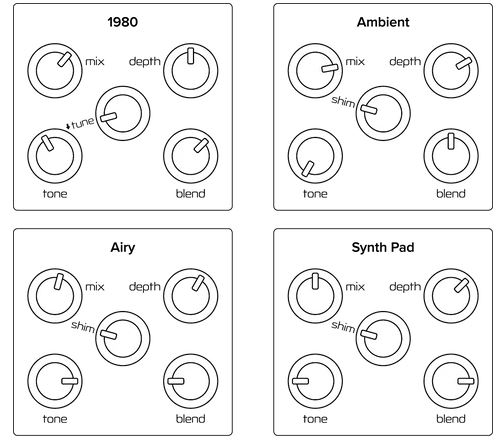
¶ Specifications
¶ Electrical
| Nominal input level | -10dBV (instrument / consumer line level) |
| Maximum input level | 7 dBV using 9 V power supply |
| Input impedance | 1.175 MΩ (mono), 2.35 MΩ (stereo) |
| Output impedance | 500 Ω (mono), 1 kΩ (stereo) |
| Gain, enabled vs. bypass | unity |
| Frequency response | 20 Hz—20 kHz, +/-0.5 dB, dry signal or bypassed |
| Total harmonic distortion | < 0.005% @ 1 kHz, dry signal or bypassed, -10 dBV input 22 Hz—22 kHz bandwidth |
| Signal-to-noise ratio | 110 dBA mono / 107 dBA stereo, enabled @ 50% Mix or trails bypass |
| 120 dBA, normal bypass |
¶ Power
| Input | 9 - 12 V DC, 100 mA |
| Connector | center-negative, 5.5 mm OD x 2.1 mm ID |
¶ Physical
| Dimensions | 2.9” W, 4.6” L, 2.0” H / 73 mm W, 117 mm L, 51 mm H |
| Weight | 8.84 oz / 251 g |
At Neunaber, we love to see what you do with your ‘toys’. We encourage you to tag us in your posts, pictures & videos featuring your Neunaber gear. To stay connected, go ahead and follow us on the channels seen below. We can’t wait to see what you do!
This product contains no user-serviceable parts.
This device complies with part 15 of the FCC Rules. Operation is subject to the following two conditions: (1) This device may not cause harmful interference, and (2) this device must accept any interference received, including interference that may cause undesired operation.
¶ WARRANTY & SERVICE:
For warranty and service information, visit our support website at support.quilterlabs.com